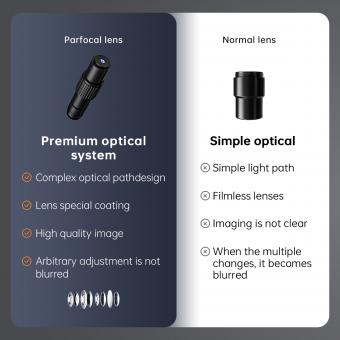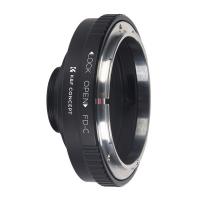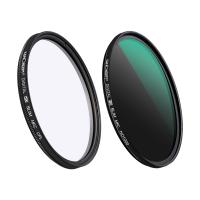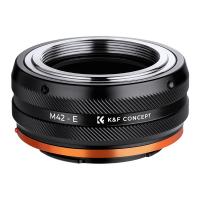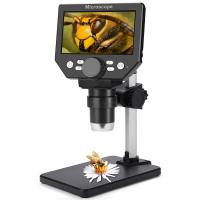What Is A Microscope Objective ?
A microscope objective is a lens system that is used in microscopes to magnify the image of a specimen. It is typically the lens closest to the specimen and is responsible for gathering and focusing the light that passes through the specimen. Microscope objectives come in different magnification powers and numerical apertures, which determine the resolution and clarity of the image produced. They are usually interchangeable and can be easily switched out to achieve different magnifications or to accommodate different types of specimens. Microscope objectives are an essential component of any microscope and are critical for observing and studying microscopic structures and organisms.
1、 Types of microscope objectives
What is a microscope objective?
A microscope objective is a lens that is used in a microscope to magnify the image of a specimen. It is the most important part of a microscope as it determines the quality of the image that is produced. The objective lens is located at the bottom of the microscope and is the lens that is closest to the specimen.
Types of microscope objectives:
There are several types of microscope objectives that are available, each with its own unique properties. The most common types of microscope objectives include:
1. Achromatic objectives: These objectives are designed to correct for chromatic aberration, which is a type of distortion that occurs when different wavelengths of light are refracted differently. Achromatic objectives are the most commonly used objectives in microscopes.
2. Plan objectives: These objectives are designed to correct for field curvature, which is a type of distortion that occurs when the image is not in focus across the entire field of view. Plan objectives are commonly used in high-resolution microscopes.
3. Apochromatic objectives: These objectives are designed to correct for both chromatic aberration and spherical aberration, which is a type of distortion that occurs when light rays are not focused at a single point. Apochromatic objectives are the most advanced type of objective and are commonly used in research microscopes.
The latest point of view:
In recent years, there has been a growing interest in developing new types of microscope objectives that can provide higher resolution and better image quality. One of the most promising developments in this area is the use of super-resolution microscopy, which uses specialized objectives to overcome the diffraction limit of light and produce images with much higher resolution than traditional microscopes. Another area of research is the development of objectives that can be used in combination with other imaging techniques, such as fluorescence microscopy, to provide more detailed information about the structure and function of biological specimens.

2、 Numerical aperture and resolution
What is a microscope objective? A microscope objective is a lens system that is used to magnify and focus the image of a specimen onto the microscope's eyepiece or camera. It is the most important component of a microscope as it determines the quality of the image that is produced.
One of the key parameters that determine the quality of the microscope objective is the numerical aperture (NA). The NA is a measure of the lens's ability to gather light and resolve fine details in the specimen. The higher the NA, the better the resolution of the microscope objective. In recent years, there has been a trend towards developing microscope objectives with higher NAs to achieve higher resolution and better image quality.
Resolution is another important parameter that determines the quality of the microscope objective. Resolution is the ability of the microscope to distinguish between two closely spaced objects. The resolution of a microscope objective is determined by the wavelength of light used and the NA of the lens. In recent years, there has been a lot of research in developing new techniques to improve the resolution of microscope objectives. One such technique is super-resolution microscopy, which uses fluorescent molecules to achieve resolutions beyond the diffraction limit of light.
In conclusion, a microscope objective is a critical component of a microscope that determines the quality of the image produced. The numerical aperture and resolution are two key parameters that determine the quality of the microscope objective. With the development of new technologies, there is a continuous effort to improve the resolution and image quality of microscope objectives.

3、 Magnification and field of view
A microscope objective is a lens that is used in a microscope to magnify the image of the specimen being observed. It is the most important part of the microscope as it determines the quality of the image produced. The objective lens is located at the bottom of the microscope and is responsible for gathering light from the specimen and focusing it onto the eyepiece.
The two most important characteristics of a microscope objective are magnification and field of view. Magnification refers to the degree to which the image of the specimen is enlarged, while field of view refers to the area of the specimen that can be seen through the microscope. The magnification and field of view of a microscope objective are determined by the curvature of the lens and the distance between the lens and the specimen.
In recent years, there has been a growing interest in developing new types of microscope objectives that can provide higher resolution and better image quality. One such development is the use of super-resolution microscopy, which uses specialized objective lenses to overcome the diffraction limit of light and produce images with much higher resolution than traditional microscopy.
Another area of research is the development of objective lenses that can be used in non-invasive imaging techniques, such as optical coherence tomography (OCT). These lenses are designed to provide high-resolution images of biological tissues without the need for invasive procedures.
Overall, the microscope objective is a critical component of any microscope, and ongoing research is focused on developing new and innovative lenses that can provide even better image quality and resolution.

4、 Objective coatings and materials
What is a microscope objective? A microscope objective is a lens that is used to magnify the image of a specimen in a microscope. It is the most important part of a microscope as it determines the quality of the image that is produced. The objective lens is located at the bottom of the microscope and is responsible for gathering light from the specimen and focusing it onto the eyepiece.
Objective coatings and materials are important considerations when choosing a microscope objective. Coatings can improve the performance of the objective by reducing reflections and increasing light transmission. Materials can also affect the performance of the objective, with some materials being better suited for certain applications than others.
One of the latest developments in objective coatings is the use of anti-reflective coatings. These coatings are designed to reduce the amount of light that is reflected off the surface of the objective, which can improve the contrast and clarity of the image. Another recent development is the use of multi-layer coatings, which can further improve the performance of the objective by reducing chromatic aberration and increasing light transmission.
In terms of materials, there has been a trend towards using high-quality glass materials in microscope objectives. These materials can provide better optical performance and reduce distortion in the image. There has also been an increase in the use of specialized materials, such as fluorite and apochromatic glass, which can provide even better optical performance for specific applications.
Overall, the choice of objective coatings and materials can have a significant impact on the performance of a microscope. By staying up-to-date with the latest developments in these areas, researchers and scientists can ensure that they are using the best possible microscope objective for their specific needs.

















